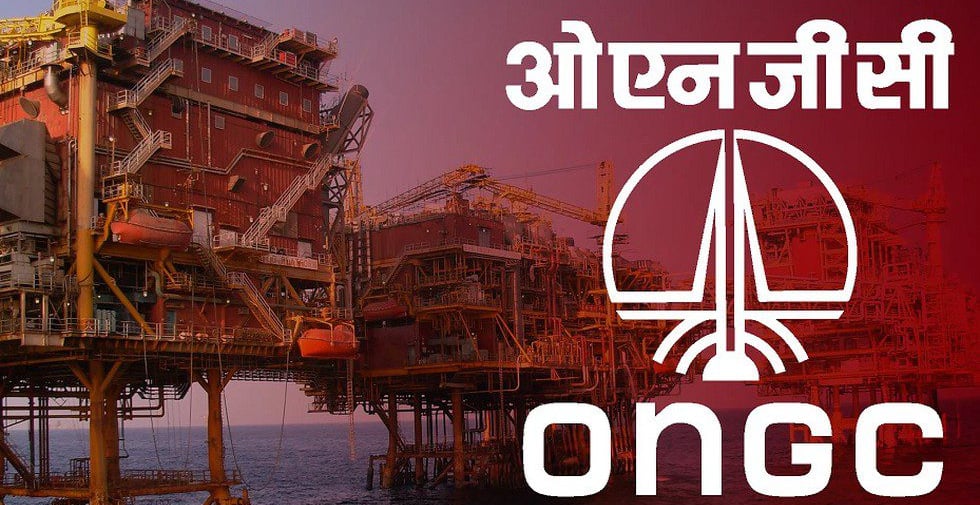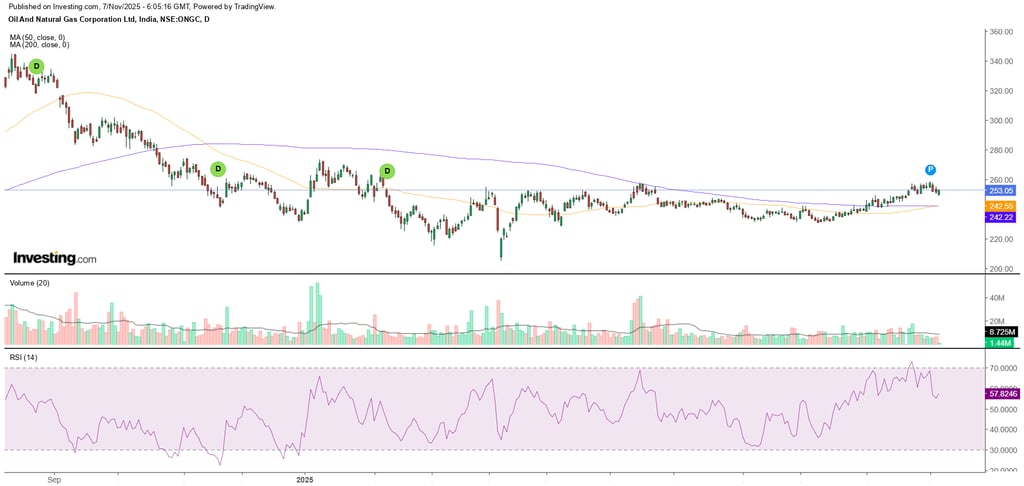Oil & Natural Gas Corporation Ltd.
Oil & Natural Gas Corp. Fundamental and Technical Analysis
STOCK ANALYSIS
11/6/20255 min read


About Company
The largest government-owned company in India, Oil and Natural Gas Corporation Limited (ONGC), focuses on the exploration and production of natural gas and crude oil. ONGC was established in 1956 and produces over 84% of India's natural gas and 70% of its domestic crude oil. Owned by the Government of India through the Ministry of Petroleum and Natural Gas, ONGC has its headquarters in New Delhi and works throughout the whole value chain of the oil and gas sector. Additionally, ONGC has an international affiliate, ONGC Videsh, which oversees oil and gas projects worldwide across 15 nations. With Maharatna status, the corporation is among India's most important and lucrative energy-related businesses, contributing significantly to the nation's economic development and energy security.
Business Segments
The three primary business segments of the oil and natural gas sector are upstream, midstream, and downstream. In the upstream section, businesses look for underground reservoirs and dig wells to obtain natural gas and oil. It is a phase that requires a lot of capital and is very risky. Oil and gas are transported from extraction sites to refineries via pipelines, shipping, and trucks as part of Midstream's focus on raw material storage and transportation. The downstream section deals with the refinement of natural gas and crude oil into final goods like heating oil, diesel, jet fuel, and gasoline, as well as the distribution and sale of these goods to customers through establishments like gas stations. From resource discovery to consumer delivery, these segments collectively comprise the whole oil and gas industry's value chain.
Company Facilities
The entire production process is supported by a variety of facilities run by oil and natural gas corporations. These include natural gas plants that process raw gas by eliminating impurities and separating natural gas liquids, central tank batteries for measuring and storing crude oil before transportation, and well sites where drilling and extraction take place. Crude oil is converted into finished goods like gasoline and diesel in refineries, which are essential facilities. Tank farms hold enormous amounts of these goods before distribution. In order to guarantee the effective and secure transportation and processing of oil and gas, businesses frequently oversee vast pipeline networks, pumps, and treatment facilities. Additionally, several businesses operate petrochemical-focused complexes and training facilities for the advancement of industry expertise.
Production Capacity
The entire amount of crude oil and natural gas that businesses and nations can extract and produce within a given time frame is referred to as oil and natural gas production capacity, and it is often assessed annually. For instance, India generated roughly 28.67 billion cubic meters of natural gas and 30.49 million tons of crude oil in the fiscal year 2020–21, despite a minor decline in recent years. India has the capacity to refine over 250 million metric tons annually. Global production capacity is frequently increased by the development of current fields, technical advancements, and the exploration of new deposits. Companies spend billions to boost production capacity. One example is ONGC's multibillion-dollar projects in the Krishna Godavari basin, which aim to produce billions of cubic meters of gas and millions of tons of oil. Increasing production capacity is crucial to meeting growing energy needs and lowering reliance on imports.
Future Plans
The oil and natural gas sector's long-term goals center on striking a balance between energy needs, sustainability, and technical advancement. To improve operations and predictive maintenance, businesses are making significant investments in digital transformation technologies like artificial intelligence (AI) and machine learning. In order to lower emissions, incorporating renewable energy sources and implementing carbon capture and storage (CCS) are becoming more and more important. To improve energy security, the industry is also building infrastructure, such as natural gas pipelines and LNG export capacity. As part of a larger movement towards greener, lower-carbon energy options, oil and gas corporations are also expanding into biofuels, green hydrogen, and electric vehicle (EV) charging infrastructure. The industry is anticipated to change as a result of strategic alliances and mergers, which are motivated by the need for size, creativity, and flexibility in response to regulatory and geopolitical issues. The industry's overall goal is to maintain resilience as it moves toward a more sustainable energy future.
Financial Prospects of the Company
The market capitalization of the company is 3,15,765 crores
The stock price is 251
The price-to-earnings (PE) ratio is 8.70
The book value (PB) ratio is 273
The price-to-book value (PE x PB) is 8.00
The return on equity (ROE) is 10.6%
The return on capital employed (ROCE) is 12.0%
The annual dividend yield of the company is 4.87%
The company's sales and profits in the last 5 years
In FY 2020-21, sales were 3,03,849 crores and profits were 21,360 crores. In FY 2021-22, sales were 4,91,246 crores and profits were 49,294 crores. In FY2022-23, sales were 6,32,291 crores and profits were 32,778 crores. In FY 2023-23, sales were 6,01,581 crores and profits were 55,273 crores. In FY 2024-25, sales were 6,12,065 crores and profits were 38,329 crores.
The company's sales and profits growth in the last 5 years
In the last 5 years, sales growth was 9.06% and profit growth was 19.4%. In the last 3 years, sales growth was 7.61% and profit growth was -8.91%. In the last 1 year, sales growth was 0.35% and profit growth was -20.7%.
Investors
Shareholding Pattern
The promoter hold 58.89%, FIIs hold 6.98%, DIIs hold 19.96%, Government hold 10.30% and Public hold 3.87%
Company's latest news
On November 1, 2025, ONGC announced major changes to its senior management, including the retirement of numerous executive directors and the company secretary. To guarantee ongoing governance and operational supervision, a new compliance officer has been recruited.
Additionally, ONGC has stated that it is prepared to resume upstream operations in Syria as soon as the political and security conditions return to normal. In line with India's strategic ambitions to reestablish energy partnerships in the Middle East and Eurasia, this represents a possible return after more than ten years.
Technical Analysis
Company Chart


Moving Average (MA)
The stock is trading above the 50-MA, which indicates that the stock may continue to go up in the near future.
The stock is also trading above the 200-MA, which is a strong sign that the stock has entered a bullish zone.
Relative Strength Index (RSI)
Currently, the RSI of the stock is 57, which indicates that the stock is neither in the overbought zone nor the oversold zone.
Chart Patterns
Chart patterns show that the stock price has come down due to weaker market sentiments and global instability but now it seems that the stock will move upward in upcoming months
Strengths and weaknesses of the company
Strengths
Largest crude oil and natural gas producer in India with a strong brand name and government backing.
High profit margins and significant revenues.
Diversified portfolio including exploration, production, refining, petrochemicals, and power generation.
Advanced capabilities with over 100 drilling rigs and experience in deepwater wells.
Extensive international presence with assets in multiple countries.
Integrated operations allow operational efficiencies.
Leading position in India’s natural gas market.
Weaknesses
Slow decision-making due to government ownership and regulatory procedures.
Declining production from ageing oil and gas fields.
High operational costs and losses from natural gas production due to regulated prices.
Fierce competition from domestic and international players.
Ageing infrastructure requires costly upgrades.
Increasing challenges from the global shift to renewable energy and electric vehicles.
Analysis
In the energy industry, particularly in India, Oil & Natural Gas Corporation (ONGC) stock is regarded as a solid and reliable investment. Because it is owned by the government, it is dependable and supported. The exploration and production of oil and gas, ONGC's primary industry, generates a consistent flow of income. However, shifts in governmental regulations, shifts in the demand for energy, and variations in the price of oil globally can all have an impact on the stock. Although its profitability is currently steady, competition and aging oil fields cause problems. Though careful investors should keep an eye on changes in oil prices and industry shifts towards renewable energy, ONGC is generally seen as a worthy long-term investment for anyone wishing to participate in India's energy market.
